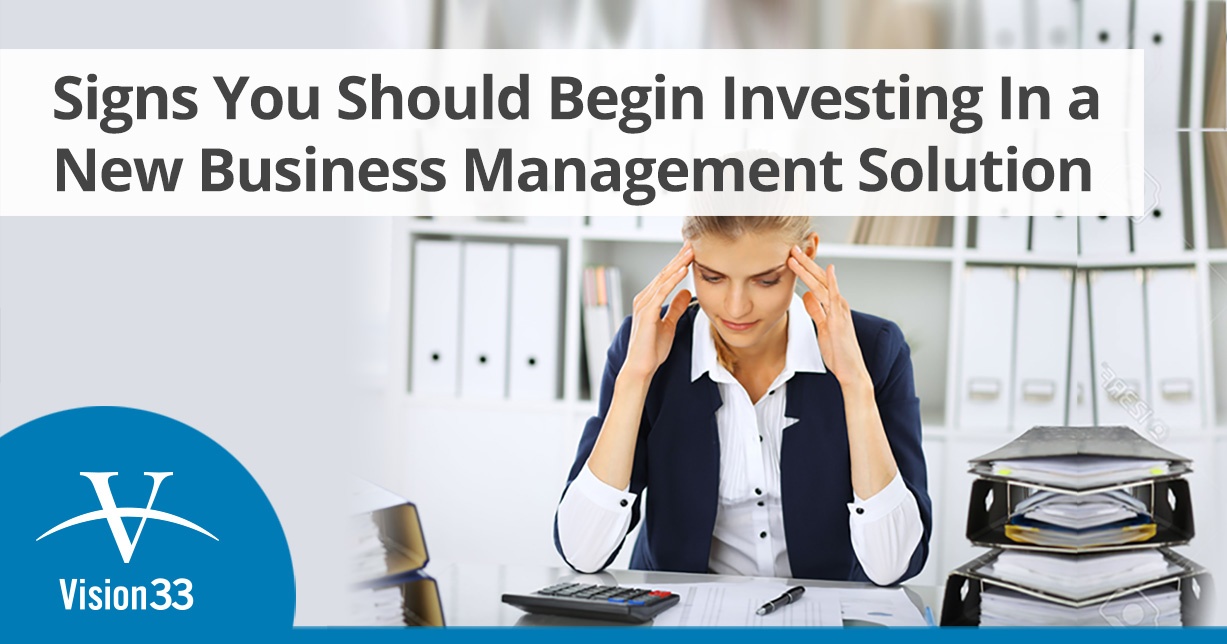If an SME spends less time running a business, and more addressing inefficiencies then it’s likely they’ve reached a stage of growth where it makes sense to move to a more efficient business management solution. Know the signs. Read the article.

How do small to midsized enterprises (SMEs) know when it is time to invest in a new business management solution? During a recent Vision33 guest speaker webinar, enterprise researcher, Cindy Jutras, president of Mint Jutras, shared early findings from a 2018 Mint Jutras Enterprise Solution Study. Mint Jutras is an independent research-based consulting firm that specialises in the analysis of enterprise applications impact on businesses. For decades, Jutras has identified the most common types of challenges facing growing businesses that signal now is the time to upgrade to a new solution. Here are a few of the common challenges facing businesses in 2018.
Lack of Control of Operations
One of the key points is that SMEs will observe that they’re not in complete control of their business. Reporting is done annually because of the downtime associated with preparing for it is significant. Data is scattered across desktops and transferred between people by hand - adding more risk of human error.
Limited Business Visibility
Another key indication is an SME has no clear idea of how or where to expand because there isn’t a clear picture of profitability. It’s difficult to do analysis based on actual historical business performance because it is incomplete data or nonexistent.
Growing Inventory
A sure sign that it’s time to move to a new business management solution is that an SME can't meet customer demand even though its inventory may be growing. There may be a higher inventory level than ever before, but it is nonetheless difficult to meet customer requested ship dates. Spreadsheets alone can no longer help forecast demand, lean out inventories, or produce products in time.
Limited Resources
Resource availability can be an indicator too. When an SME is running lean to keep up with the pace of new business, they may have limited resources at their disposal. Cash is tight, and credit is difficult to obtain. Whether an SME needs to finance supply chain costs or invest in growth, it may be a challenge to obtain credit. Additionally, an SME may have limited IT resources or no IT Staff at all which may delay a move to a new solution. With the prominence of the cloud deployment, SMEs may need a partner to take care of IT full time to free up resources to focus on business growth.
Aging Business Management Technology
Is that technology is leaving you behind? You're growing, and you'd rather invest in new revenue-generating opportunities, not in aging overhead to keep it running. However, you can't respond to the demands of your trading partners, customers and suppliers, you can't respond to the demands of the digital economy.
Why is Now the Time to Move to a New Business Management Solution?
There isn’t a single way of knowing when the right time is to move to a new business management solution. The bottom line is that SMEs need to ask whether these challenges are hindering business performance. If an SME identifies with any of these signs, then instead of asking if you can afford to move to a new business management solution, the better question to ask is can a growing business afford to continue operating without it?
Ultimately, if an SME spends less time running a business, and more addressing inefficiencies then it’s likely they’ve reached a stage of growth where it makes sense to move to a more efficient solution. Investing in business management technology such as enterprise resource planning (ERP) solution has become more affordable than ever before. At the same time, ease-of-use feature functionality has gone up. Partnering with a world-class ERP partner for software implementation can enable positive change in the business of an SME by providing ongoing savings to sustain and grow business.
Watch the Vision33 Guest Speaker Webinar Series video featuring Cindy Jutras to hear find out why SMEs can afford ERP.

